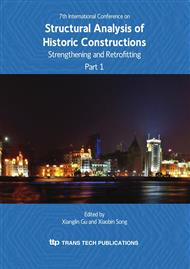p.1219
p.1225
p.1233
p.1241
p.1247
p.1253
p.1259
p.1265
p.1271
Behavior of Circular Concrete Columns Repaired with Steel Bars and Wire Mesh-Mortar
Abstract:
In order to increase the strengthening efficiency of steel bar mat-mortar (BM) jacket and wire mesh-mortar (WM) jacket around existed circular concrete columns, an attempt to strengthen the columns with hybrid bar mat-wire mesh-mortar (HBWM) jacket was proposed. A comparatively experimental study on axial compression behaviors of concrete columns wrapped with three different strengthening systems, namely BM, HWBM and carbon fiber reinforced polymer (CFRP) was performed. The experiment results showed that much more cracks appeared in HWBM columns compared with those in BM columns. As a result, on the premise that the concrete compressive strength of the HWBM columns increased 90% compared with that of the BM columns, the ductility of the HWBM columns reached about twice as that of the BM columns. The increase of the concrete compressive strength of CFRP strengthened columns was higher than those of HWBM and BM strengthened columns. The ductility of CFRP strengthened columns, however, was obviously lower than that of HWBW columns.
Info:
Periodical:
Pages:
1247-1252
Citation:
Online since:
October 2010
Authors:
Price:
Сopyright:
© 2010 Trans Tech Publications Ltd. All Rights Reserved
Share:
Citation:


